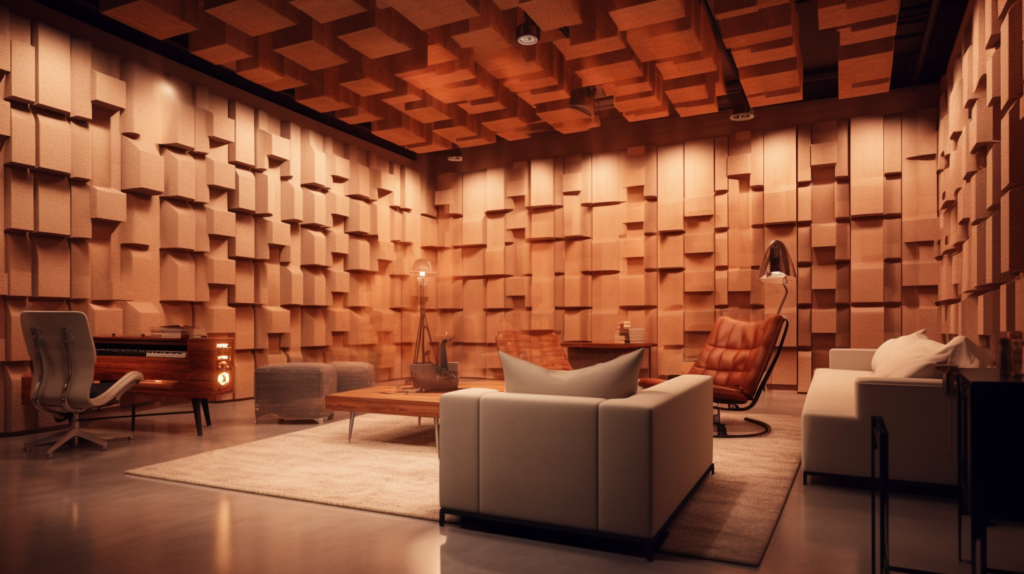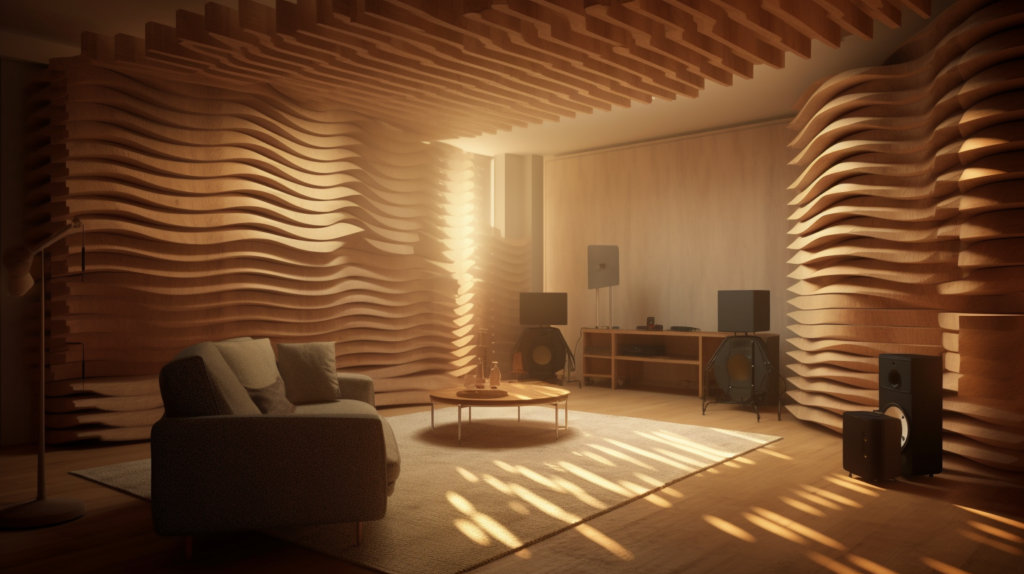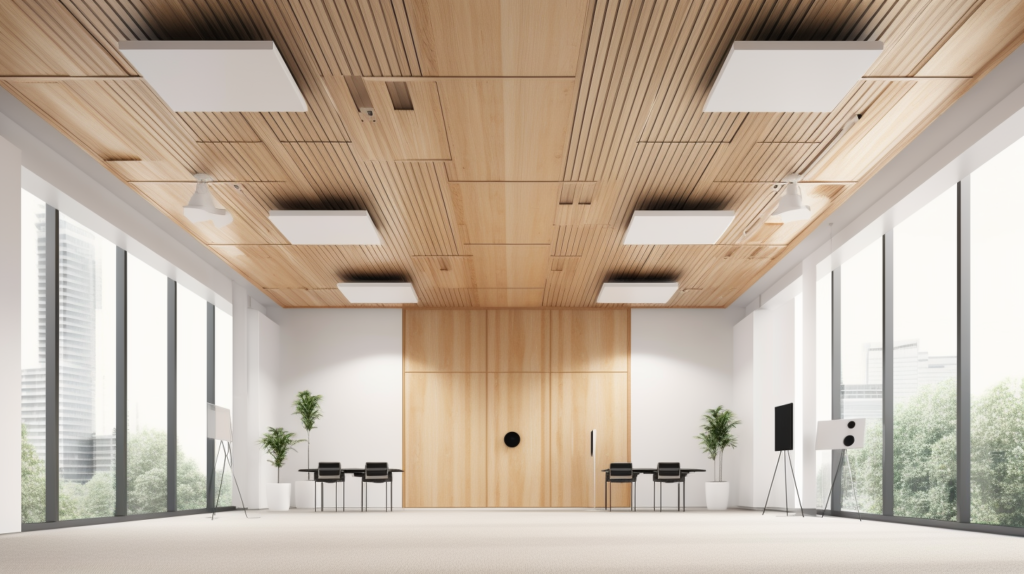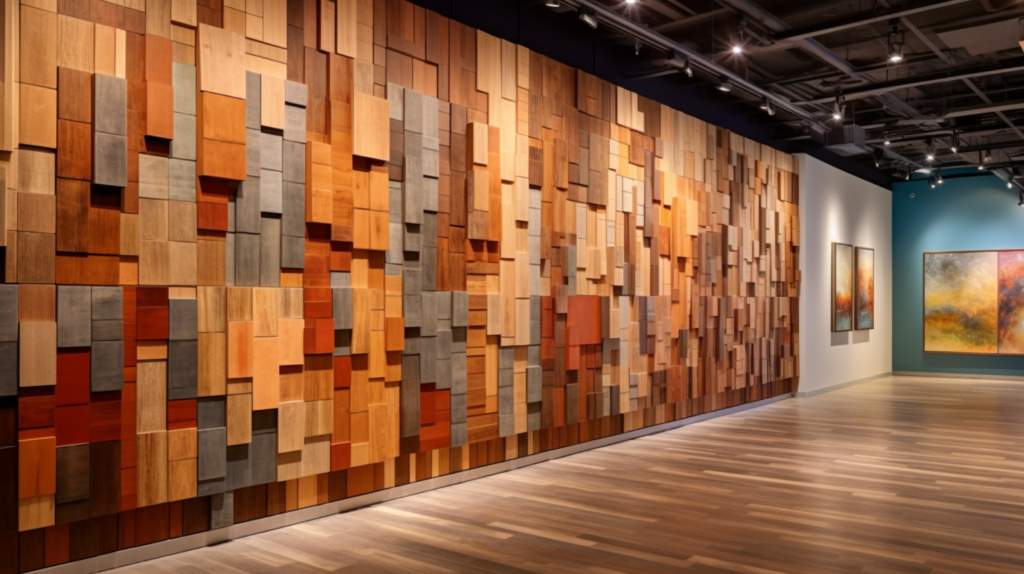The sound of your voice echoing back as you speak, the roar of noise making it impossible to think—poor acoustics can ruin an otherwise pleasant space.
Installing wood acoustic panels offers an attractive and effective solution for absorbing excessive noise and improving the acoustic environment.
From recording studios to restaurants to home theaters, wood acoustic panels tune sound in a variety of residential and commercial spaces.
Let’s explore what wood acoustic panels are, how they reduce noise, optimal installation, the materials used, and their costs and benefits.
What Are Wood Acoustic Panels?

Wood acoustic panels are panels made from wood that are installed in rooms to help absorb and reduce noise.
They are commonly used in spaces where controlling sound is important, such as recording studios, theaters, and auditoriums.
The porous, fibrous structure of wood allows it to absorb sound waves energy rather than reflect it back into the room, making these panels effective at reducing echo, reverberation, and improving overall sound quality.
Different wood species and manufactured wood products can be used to create acoustic panels, including solid wood boards, plywood, MDF, and others.
The choice of material affects the panels’ aesthetic appearance, durability, sound absorption capabilities, and cost.
Wood panels are often a visually appealing acoustic treatment option compared to materials like fabric and acoustic foam.
The fibrous structure of wood materials allows the panels to effectively absorb sound energy rather than reflect it, reducing issues like echo and excessive reverberation.
Strategic placement on walls and ceilings improves room acoustics.
Wood Acoustic Panel Materials
There are various wood materials like solid boards, plywood, MDF that can be used to construct acoustic panels, each with their own characteristics.
The material chosen impacts factors like cost, durability, sound absorption and aesthetics.
Acoustic Panel Applications
Wood acoustic panels are commonly used in spaces like recording studios, theaters and auditoriums where controlling sound quality and reverberation is important.
The ability to absorb and diffuse sound makes them ideal treatment for these types of rooms.
How Do Wood Acoustic Panels Reduce Noise?

When sound waves hit a hard surface, some portion of the sound energy gets absorbed while some is reflected back.
The rigid, dense materials used in many building interiors, like concrete, tile, glass, and drywall, are very reflective and cause echoing and reverberation issues.
Wood acoustic panels work by absorbing the sound waves energy instead of reflecting it back into the room.
Absorbing Sound Waves
The porous, fibrous composition of wood materials converts sound into heat energy as sound passes through and causes the wood fibers to vibrate.
The vibration dissipates the sound so that less gets reflected back.
Wood panels tuned to specific thickness and density can target certain frequency ranges for absorption.
Airspace behind panels also plays a role in this sound dampening effect.
Reducing Noise Issues
Strategically placing wood acoustic panels on walls and ceilings can help reduce noise issues like echo and excessive reverberation by absorbing sound waves before they bounce around the room off hard surfaces.
This improves clarity.
What Is The Benefit Of Wood Acoustic Panels

There are several key benefits to using wood acoustic panels as a sound absorption solution.
They are effective at reducing echo/reverberation and improving sound clarity in a space.
The natural sound absorbing properties of wood work to soften harsh reflections.
Wood panels absorb sound waves across a broad frequency range based on thickness/density, allowing customization to target specific pitches.
This versatility makes them suitable for many applications.
They have an attractive visual aesthetic compared to materials like fabric or acoustic foam.
Wood panels can complement a variety of design styles. Durable wood materials resist wear and can be long-lasting if properly maintained.
Smooth surfaces also help minimize dust buildup. Wood is relatively affordable and accessible as an acoustic panel material. It’s cost effective compared to custom fabricated absorbers.
Helps reduce noise pollution by absorbing sound waves rather than reflecting them back into the environment.
This creates a more pleasing sound. The natural sound absorbing properties of wood make it an ideal acoustic panel material for improving sound quality.
Wood panels also provide visual appeal over plain utilitarian materials.
The natural sound absorption and diffusion properties of wood provide many benefits as an acoustic panel material.
Wood panels effectively reduce excessive reverberation and echo issues while maintaining a space’s natural ambience.
They also offer an attractive aesthetic over plain industrial materials like fabric or foam.
When properly placed, wood acoustic panels can significantly enhance the acoustic environment.
Wood Acoustic Advantages
Wood provides several advantages over other materials for acoustic panels. It naturally absorbs and diffuses sound, provides visual appeal, and allows for custom fabrication.
Wood is also a cost effective option for quality acoustic treatment.
Optimal Placement Of Wood Sound Panels

Properly placing wood acoustic panels is key in order to maximize their noise reducing potential in a space.
Some guidelines for optimal wood panel placement include installing panels at reflection points where sound bounces off hard surfaces, like beside windows or under ceiling corners.
This reduces harsh reflections. Place panels at strategic points along room perimeters where sound buildup tends to occur.
Spreading panels out evenly is more effective than clustered placement. Mount panels on the ceiling to absorb sound traveling upwards and reduce reverberation from above.
Overhead placement is great for rooms with high ceilings. Corner mounting helps catch sound in two directions coming off perpendicular walls.
Corners also cause sound buildup. When possible, leave airspace behind wall mounted panels to improve low frequency absorption.
Depth behind panels is helpful. Experiment with angled or staggered panel placement to catch sound waves from multiple directions. Break up parallel surfaces.
Proper placement maximizes the noise reducing capabilities of acoustic panels. Spreading panels evenly provides the best coverage for absorbing sound waves and preventing excessive reverberation.
Strategic Panel Placement
Carefully planning acoustic panel placement is vital to maximize their effectiveness. Spreading panels evenly helps absorb sound from all directions.
Leaving air gaps behind panels and installing them at an angle also improves low frequency absorption. Proper placement is key.
Installation Guidelines
There are some general guidelines to follow for optimal acoustic panel placement, like spreading them evenly, mounting them overhead and at corners, and leaving airspace behind wall panels.
Testing different configurations maximizes acoustic benefits.
Types Of Wood Materials Used For Acoustic Panels

There are several different types of wood materials commonly used to make acoustic panels, each with their own characteristics.
Solid wood panels made from boards provide nice aesthetics and natural sound absorbing properties. Pine boards are a popular choice.
Plywood offers durability and consistent quality. It can be worked into various shapes and thicknesses.
It’s available in many wood veneers. MDF is an engineered wood product that is smooth, stable and consistent for fabrication.
It lacks the texture of solid wood but has good acoustical properties. Perforations in wood panels increase sound absorption.
Holes break up reflective surfaces and allow sound waves to pass through. Thin wood veneers applied over substrates provide the visual look of solid wood at a lower cost.
They can cover plywood or MDF. Acoustic wood composites combine wood fibers with other sound absorbing materials for enhanced acoustic performance.
Different wood materials bring their own characteristics to acoustic panels in terms of sound absorption, aesthetics, cost, durability and workability.
Wood Panel Materials
There are a range of wood materials to choose from when constructing acoustic panels, each with different properties that affect sound absorption, durability, cost and aesthetics.
Selecting the right material for the intended application is important.
Material Comparisons
Solid wood, plywood, MDF and composites each have relative pros and cons in terms of acoustic performance, appearance, cost and durability.
The ideal material depends on project needs.
Costs And Considerations Of Wood Sound Panels

Wood acoustic panels provide excellent sound absorption and aesthetic value at a reasonable cost.
However some considerations around using wood panels include costs varying based on material used and panel size, but are generally $25-$100 per panel installed.
Solid wood is more expensive than composites. Installation is relatively straightforward but may require anchors, adhesive and tools to mount panels properly.
Hiring a professional is advised for large scale soundproofing projects and commercial acoustic panel installation.
The fire rating and codes for wood panels should be reviewed, especially for commercial spaces.
Fire protection treatments may be required. Moisture and humidity can negatively impact wood over time.
Proper climate controls and maintenance are recommended to prevent warping or deterioration issues.
Cleaning dust and dirt from wood surfaces periodically helps maintain acoustic performance and visual appeal. Avoid abrasive cleaners.
Acoustic panels should be installed intelligently based on optimal placement guidelines to maximize sound absorption and reduce noise.
Consider an acoustic panel solution like wood to improve sound quality and reduce reverberation/echo issues.
On the whole, wood acoustic panels provide good value but require proper installation and maintenance for best acoustic results and longevity.
Acoustic Panel Costs
While wood acoustic panels provide cost effective sound treatment, upfront material and installation costs should be considered.
Ongoing maintenance is also required for optimal longevity.
Maintenance Needs
Keeping wood acoustic panels looking and performing well requires some periodic maintenance like cleaning, climate control, and watching for damage or deterioration over time.
Proactive care ensures longevity.
Conclusion
Wood acoustic panels provide an excellent way to improve sound quality and reduce noise issues in a range of residential and commercial spaces.
With benefits like effective sound absorption across frequencies, attractive visual appeal, and cost effective fabrication, wood is often a superior acoustic panel solution over utilitarian materials like fabric or foam.
By selecting the right wood materials and placing panels strategically throughout a space, acoustic energy can be tuned, absorbed and diffused.
While some maintenance and care is required, properly installed wood panels will provide long-lasting acoustic control and design versatility.
If echo, reverberation or noise is a problem in a room, considering an application of wood acoustic panels can be a great solution for enhancing the sound environment.
